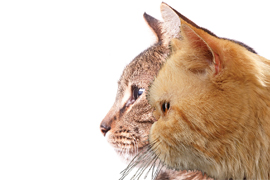Standing up for the veterinary profession
08 Aug 2024
08 Aug 2018 | Claire Bessant
Claire Bessant, Chief Executive of International Cat Care, discusses the problems and suffering associated with flat-faced pedigree cats.
 The basic design of the domestic cat is fundamentally sound. As da Vinci said, ‘The smallest feline is a masterpiece.’ It’s a design that evolved through functionality - cats needed to hunt, kill prey, in turn avoid being killed by predators, reproduce and lead a vigorous athletic life.
The basic design of the domestic cat is fundamentally sound. As da Vinci said, ‘The smallest feline is a masterpiece.’ It’s a design that evolved through functionality - cats needed to hunt, kill prey, in turn avoid being killed by predators, reproduce and lead a vigorous athletic life.
The result is a fit, elegant, lithe animal that should, if fed and housed properly (and neutered), have few health issues and live a long life. The non-pedigree cat the world over looks remarkably consistent in size and shape, with hair, upright ears and a tail.
Of course humans like variety and something different, so we have created cat breeds, just as we have dog breeds, although cat breeds have not been developed to perform specific functions as dog breeds originally were.
The problems associated with flat faced pedigree dogs, such as the pug and French bulldog, have become more recognised and more publicised recently. The cat world has its own version of pugs and bulldogs – the Persian and Exotic Shorthair breeds (an Exotic is basically a short-haired Persian with the same body size and shape) with flattened faces and associated changes to skull shape. This change in the shape of the skull causes many problems. Obstruction of the system by which tears keep the eye lubricated and drain away through the tear ducts results in tears overflowing onto the face, causing staining and skin problems.
The eye may not be lubricated properly as a result either. These cats often have excessive folds of skin on their faces which can harbour bacterial and or fungal disease and these folds can also rub against the eye. Jaw shape can affect the cat’s ability to pick up food, and teeth grow through at strange angles so the cat may not be able to eat properly and food may accumulate between the teeth. The facial conformation changes that result in problems in dogs are present in brachycephalic cats too, such as, pinched or narrow nostrils and nasal cavities, which result in noisy breathing, and breathing that may stop and start during sleep. Lastly the reduced skull size results in the brain being squashed and may result in neurological problems.
While there may be an argument that some brachycephalic cats do not have such flattened faces as others, there is no excuse not to condemn breeding of the Scottish Fold – osteochondrodysplasia (a disorder of the development of bone and cartilage) not only results in the abnormal forward folding of the cat’s ears which give it that cute, baby face that people desire, but it also affects cartilage throughout the body, meaning that these cats develop painful arthritis for much, if not all of their lives.
The Manx cat we can all recognise is also prone to spina bifida and associated complications which may be irreparable or require surgical intervention.
You could also argue that the cat has a barbed tongue, one of the functions of which is grooming. A cat with no coat still has a natural desire to groom but will rasp its skin rather than untangle its coat. The oil which is used to waterproof hairs is still produced and can cause skin problems and the cat will need bathing or cleaning regularly by a person. Perhaps we should be pleased it has a good length nose and no movement difficulties. If we take one off genetic abnormalities (eg, a hairless kitten) to produce a breed, we need to realise our intentions are not for the good of the cat, but to enjoy the power of making something different which then may need human intervention to survive without suffering and despite its natural behavioural needs.
At present there are fewer problems in cats than in dogs, but some which need urgent attention. If we work on the premise that breed variety is fine if the body which has been intentionally manipulated for a certain ‘look’, does not cause the cat any more difficulties than one which nature has honed, then that is fine. The good old moggie in general has usually been shaped by nature, that hardest to task master of all, and so is pretty fit for purpose. New designs created by man can have pretty coat colours or patterns or even some change in body shape, but first no harm should be done.
Get tailored news in your inbox and online, plus access to our journals, resources and support services, join the BVA.
Join Us Today